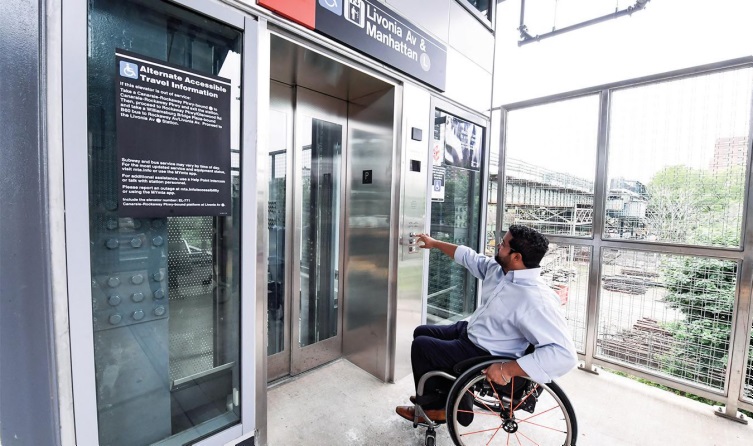WHAT'S HAPPENING
NEW YORK SUBWAY SYSTEM SETS 33-YEAR TIMELINE FOR MAKING 95% OF ITS STATIONS FULLY ACCESSIBLE
New York City's subway system will finally become more accessible to people with disabilities or mobility challenges – in 33 years. As Michael Gold reports in The New York Times, "New York has lagged for years behind other major American cities in making its subway system accessible to people with disabilities: Just 126 of its 472 stations, or 27 percent, have elevators or ramps that make them fully accessible."

LOOKING UP: New elevators and overpass open to the public at the Livonia Ave station on the L line, on Wednesday, June 1, 2022.
MTA officials announced a decades-long commitment to make 95% of the city's subway system accessible to New Yorkers with disabilities, who are all but shut out from the vast majority of the city's aging subway system.
Only about one fourth of the system's elevators are currently wheelchair-accessible, and regular breakdowns of elevators makes the system even more difficult to navigate for those with mobility issues.
The commitment to build more ramps and elevators comes through a settlement to a pair of lawsuits filed by disability advocates against the transit agency that claim officials continue to violate state and federal law by running a subway system that locks out wheelchair users.
Cities with newer systems like San Francisco and Washington are fully accessible. But even though New York City's transit system is very old, other systems of similar age, like those in Boston and Philadelphia, are far more accessible than the Big Apple's with around two-thirds of those cities' stations in compliance with the standards set by the Americans With Disabilities Act.
The ADA, which was passed in 1990, is
a civil rights law established to prevent discrimination based on disability. It states that any public facility that was built after 1993 must be accessible. For the City of New York, given its much older subway system (which is the world's largest transit system by station count), the federal government and the transit agency came to an agreement, which required the city to implement accessible access to 100 "key stations" by 2020, a goal that was achieved. The agreement requires the MTA to contract to build ramps and elevators at 81 stations on the subway and Staten Island Railway by 2025; another 85 by 2035; 90 more by 2045 and another 90 by 2055. It's unclear how long it will take to construct all of the accessibility features after the contracts are issued.
"We need to make a system that is truly accessible for not only our disabled people, but also for older people with mobility issues and that burgeoning population of New Yorkers who are racing around with strollers," MTA chairman Janno Lieber said during an event Wednesday.
The deal ends a years-long legal battle
fought by disability advocates in court over the MTA's historically sluggish approach to accessibility.
One lawsuit settled this week claims the Metropolitan Transportation Authority is in violation of New York City's Human Rights Law by not having enough accessible stations. Another argues the agency regularly violates the Americans with Disabilities Act of 1991 by doing construction at stations without also building ramps and elevators.
"Disabled In Action has fought to eliminate barriers to full equality for people with disabilities for more than 50 years and is proud to do so here on behalf of all New Yorkers," Jean Ryan of Disabled In Action New York said in a statement. "All our members need elevators in the subways, and we need elevators in all stations. Elevators are for everyone."
The MTA still faces a lawsuit from advocates surrounding maintenance of subway elevators, which regularly break down or close for repairs with little notice to riders who rely on them. Another argues the agency regularly violates the Americans with Disabilities Act of 1991 by doing construction at stations without also building ramps and elevators.